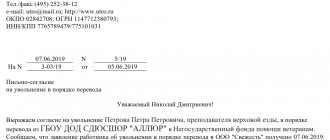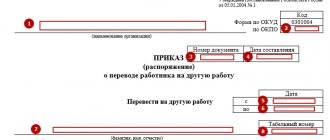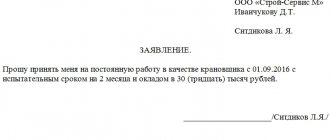Reasons for remote transfer
The Labor Code does not indicate when it may be necessary to transfer an employee to remote work; this issue remains at the discretion of the employer.
The relocation is formalized if an employment contract was not initially concluded for the remote nature of the work, but a need arises for it, or the parties reach an agreement on the possibility of a specialist performing labor functions outside the location of the organization. A temporary transfer, in accordance with the amendments made to the Labor Code of the Russian Federation FZ-407 and coming into force on January 1, 2022, is possible in the event of force majeure circumstances for the duration of their effect. When moving to remote mode on the initiative of the employee or by agreement of the parties, an additional agreement is signed; temporary movement is carried out without the consent of the employee.
ConsultantPlus experts discussed how to transfer an employee to another position. Use these instructions for free.
In remote work, interaction between employee and employer occurs through telecommunication networks. Remote document flow is organized according to the rules specified in the employer’s local regulations. Issues of working hours, interaction, employee communication, control over the performance of work duties are determined in the employer’s local regulations. The Labor Code of the Russian Federation from 01.01.2021, in accordance with current amendments, allows the parties to regulate these conditions in internal regulations, rules, etc.
Basic information about remote work
Remote work has its advantages for management and subordinates. However, only certain categories of employees can be transferred to this type of work: those whose work is not related to being on the employer’s territory. These could be lawyers, programmers, human resources workers, that is, those who are not involved in production, cleaning, cooking, teaching, etc.
Attention! The Labor Code contains rules governing remote work in Chapter 49.1.
An employee can be transferred to this type of work only with his consent (Article 72 of the Labor Code of the Russian Federation). If the initiator is an employee, then he must submit an application with a request to work remotely, then the employer draws up an additional agreement, issues an order about this, and the employee begins to perform his work tasks from home.
If the initiator of the transfer is the manager, then he must notify about the change in working conditions 2 months in advance, no later. You need to get the consent of the future remote worker, then they draw up an additional agreement to the employment contract and issue an order.
When remote work is recommended by law, the transfer can be completed in a short time, without waiting 2 months.
Before drawing up an agreement, the employer and employee must agree on the new work and rest schedule, how work will be controlled, how communication with the employee will be established and other important details.
For your information! Remote workers are subject to all the guarantees provided to other employees; wages should not be reduced, time off for work on holidays and weekends, etc. must be paid in accordance with the law.
Transfer procedure
We prepare the translation
To transfer an employee to remote work, conduct an audit of the technical capabilities of the organization and the specialist himself. It is necessary to ensure that production facilities are available at the potential workplace or to provide additional resources. Make lists of those you plan to transfer to remote work. Decide on the organization of the process: work and rest schedules, interaction patterns, methods of control, develop and adopt a local regulatory act.
In accordance with the Labor Code of the Russian Federation, the main stages are defined for how to transfer an employee to remote work:
- drawing up a statement or consent (exception - temporary transfer);
- signing of an additional agreement;
- publication of an order for the enterprise.
An application for switching to a remote mode is drawn up in free form, the employee expresses a desire to work remotely, indicates the reasons, the date from which he wants to switch to the new mode, the parties agree on the conditions, and the manager endorses the application. Temporary transfer is carried out on the basis of an order from a government agency, the publication of a law or decree, or an order on the occurrence of an emergency situation.
The main significance when moving an employee with whom an employment contract has already been concluded to remote mode is the additional agreement. It defines a new procedure for interaction for the parties, rules for document management, or makes reference to a local regulatory act and the fact that the worker has become familiar with it.
Here is an example of an additional agreement for remote work (blank form):
| Additional agreement No.__ to the employment contract dated ___________ No. 1-TD |
Limited Liability Company "_____", hereinafter referred to as the "Employer", represented by General Director _______, acting on the basis of the Charter, on the one hand, and ____________, hereinafter referred to as the "Employee", on the other hand, have entered into this additional agreement to the employment agreement dated _________ No.__ on the following:
1.1. Add to section “1. Subject of the agreement" of the employment contract, clause 1.3 as follows:
"1.3. The work performed by the Employee under this employment contract is remote, that is, the Employee performs duties outside the location of the Employer, its branch, representative office, outside a stationary workplace, territory or facility under the control of the Employer, provided that it is used to perform this job function and for interaction between the Employer and the Employee of public information and telecommunication networks, including the Internet.”
1.2. Amend clause 1.4 of the Employment Agreement as follows:
"1.4. The employee performs the duties assigned to him by the employment contract in accordance with the Rules set out in the Regulations on Remote Work, which he is familiarized with separately. The place of work is determined by him at his own discretion.”
1.3. In paragraph “6.2. Responsibilities of the employer" of the employment contract, add points:
"6.2.9. Every month, no later than the 15th, reimburse the Employee for expenses incurred for the Internet and mobile communications, based on the supporting documents submitted by the Employee.”
1.4. Amend clause 4.1 of the employment contract as follows:
"4.1. The Employee’s working hours and rest hours are established in accordance with the internal labor regulations _____________. By agreement with the manager, the Employee has the right to change the working hours, subject to mandatory compliance with the actual working time of 40 (forty) hours per week.”
2. Other terms of the employment contract not specified in this additional agreement remain unchanged.
3. This additional agreement comes into force on _________.
4. This additional agreement is an integral part of the employment contract, drawn up in two copies having equal legal force. One copy is kept by the Employer, the second by the Employee.
| Worker: | Employer: |
We draw up an additional agreement
The second step after signing the consent is the need to draw up an additional agreement on transferring the employee to remote work; this is regulated by Art. 72 TK. The basis for its conclusion will be the employee’s statement, proposal or initiative of the employer. It is recommended to provide important nuances:
- Workplace. It is difficult to define it precisely within the meaning of the law - “outside the location of the employer.” It is advisable to think about whether this specialist is needed in the office, on what days, and document this. It is allowed to both indicate the place of work of a remote worker in the employment contract in the form of an indication of the locality, and leave it at the discretion of the employee (from any location). But in accordance with changes to the Labor Code of the Russian Federation, the employer reimburses the employee for all expenses associated with performing duties remotely. And he gets the right to fire a specialist if he moves to an area where there are no conditions for remote work.
- The employee sets his own working hours. If the employer has any requirements, for example, to be on call from 9:00 to 17:00, these should also be stated in the agreement. It makes sense to indicate the length of the working week and weekends.
- Mechanisms of interaction and methods of control.
- Use of employee resources and payment of compensation.
The more detailed you are about the conditions for working remotely, the less likely you are to encounter misunderstandings, negligence or abuse on the part of both the employer and the employee.
We issue an order
The decision is formalized by an administrative act. The order is issued after an additional agreement on remote work with the employee is signed. There is no approved form; the document is drawn up in free form. It is allowed to use the T-5 form or use a self-developed form. The order is issued on company letterhead, or the details (name, TIN) are a separate part of the form.
The order reflects the fact of moving remotely, the start date of the regime, the employee’s data (last name, first name, patronymic, position, department, structural unit), indicates a link to the additional agreement, the basis - the employee’s statement or the employer’s initiative. The employer is prohibited from changing the salary when switching to remote work, if the scope of responsibilities remains the same. The employee is presented with the order against signature.
Why is an additional agreement necessary?
Remote labor relations carry certain risks for both the employee and the employer, and an additional agreement on remote work, as an official document regulating labor relations for a certain time, will allow them to be minimized.
If the document clearly states the employee’s work schedule, methods of monitoring the performance of his job duties, and details of the exchange of information, the manager will still have the levers to control his subordinate. At the same time, this gives employees guarantees that they will receive the agreed remuneration for their work, their work experience will be documented, and, if necessary, they will receive social benefits and benefits.
How to draw up an additional agreement
The additional agreement on transfer to remote work does not have a unified form. Each organization or individual entrepreneur draws it up at its own discretion, focusing on the norms of Chapter. 49.1 of the Labor Code of the Russian Federation and Art. 74 Labor Code of the Russian Federation. The document may have the following structure:
- At the top, indicate the name of the document, the number assigned to it and the details of the employment contract to which the additional agreement is concluded.
- Below indicate the date and place of the document.
- After this, it is necessary to register information about the parties to the labor relationship: full name of the employer and full name. its manager, full name employee.
Further, the text of the agreement should indicate exactly what changes will be made to the employment contract. If the conditions change indefinitely, you need to make a note that the corresponding clause of the employment contract will be stated in a new edition, for example: “The employee performs his work function remotely” and indicate the start date of remote work. If the list of duties that an employee must perform has changed, they are also listed in the additional agreement. If necessary, make notes about working hours, the procedure for sending work results and other important points.
If the other terms of the employment contract remain unchanged, the agreement also indicates this.
One copy is given to the employee, and the second remains with the employer. Both copies have equal legal force. A sample additional agreement on transfer to remote work is given below.
What are the reasons for transferring to remote work?
The Labor Code of the Russian Federation does not directly establish conditions for such a transfer. This issue is resolved at the discretion of the employer. However, such recommendations may be given by the authorized agency.
For example , as happened in the situation with the transfer of students to distance learning according to the Order of the Ministry of Education and Science. Then the teachers signed an additional agreement, but there were many nuances regarding the definitions of the very concepts of remote and remote work. Some gaps in the laws caused a number of difficulties, including regarding the length of the working day.
Starting from the new year, Russians can expect a number of amendments to the Labor Code of the Russian Federation based on No. 407-FZ, where all the subtleties of the registration process and the most remote work mode will be clearly regulated. Now, in order to transfer a teacher, pedagogue or other public sector employee to a remote location, personnel officers will first have to contact the trade union body to adopt a new local act, then make amendments to employment contracts and then draw up additional agreements with employees. All these actions are carried out using telecommunication networks at the expense of the resources of both the employer and the employees themselves.
ORDER
March 20, 2022
Moscow
No. 1-P
About transferring to remote work
In accordance with the agreement reached, I ORDER:
- Transfer sales department manager Igor Aleksandrovich Petrov to remote work from March 23, 2022.
- Save for Petrov I.A. the obligation to perform his labor functions in full, in the same position and with the same salary.
- To the HR department data on the time worked by I.A. Petrov. within a month, submit to the accounting department as for a full month of work in the absence of documents confirming the presence of non-working periods in this month (vacation, sick leave).
Reasons:
- Statement by Petrov I.A. dated 03/19/2020 on transfer to remote work from 03/23/2020.
- Additional agreement dated February 20, 2020 No. 1 to the employment contract dated February 11, 2018 No. 135.
Director
Borisov
Borisov A. S.
What to include in an additional agreement
The additional agreement should establish that, due to the unfavorable epidemiological situation, a remote work mode is introduced for the employee in accordance with Article 312.1 of the Labor Code of the Russian Federation. This, in particular, means that the employee will perform the functions specified in the employment contract outside the location of the employer (its branch, representative office, other separate structural unit), as well as outside a stationary workplace, territory or facility directly or indirectly under the control of the employer. In this case, the employee will use the Internet to perform work duties and interact with the employer.
Compose HR documents using ready-made templates for free
REFERENCE. The Labor Code does not require the specific address to be indicated in the additional agreement at which the employee will be “remotely” while performing work duties.
Separately, the additional agreement must indicate that it is temporary. In this case, it is possible to set a clear expiration date for the agreement, coinciding with the “quarantine” periods introduced by the state: for example, May 1 or June 1. Or it is permissible to determine the end date of the “additional warning” by indicating a specific event: an improvement in the sanitary and epidemiological situation or the abolition of the high alert regime in the relevant area. After the specified date arrives or the specified event takes place, the version of the employment contract that was in force before the conclusion of the additional agreement will begin to apply again.
IMPORTANT. A remote transfer does not automatically imply a salary reduction. But when signing an additional agreement, the parties can agree to reduce wages in connection with a change in the list of job responsibilities of a person who will work from home (if some part of the job functions cannot be performed “remotely”).
Calculate advance and salary taking into account all current indicators
In addition, the additional agreement must specify the procedure for supplying the employee with the necessary resources. It is acceptable to establish that the employee provides himself with a computer, printer, etc. In this case, you need to determine the amount of compensation for the use of the employee’s equipment and the amount of reimbursement for telephone and Internet expenses (for more details, see the next article).
Finally, the additional agreement stipulates the deadlines and procedure for submitting the work, as well as the methods and frequency of communications with the employer (Article 312.3 of the Labor Code of the Russian Federation).







